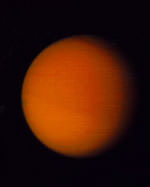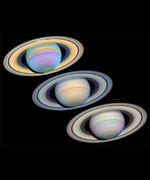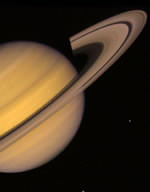
Image credit: NASA
Astronomers from Cornell university have used the Arecibo radio telescope to peer through the thick clouds on Titan, Saturn’s largest moon. The radar signatures on the surface of Titan seem to indicate a liquid surface; although, the researchers say the signals could also mean smooth solid surfaces too. More answers will come next year when the Huygens probe carried by the Cassini spacecraft will drop through the clouds and send back information about the surface of Titan.
The smog-shrouded atmosphere of Titan, Saturn’s largest moon, has been parted by Earth-based radar to reveal the first evidence of liquid hydrocarbon lakes on its surface. The observations are reported by a Cornell University-led astronomy team working with the world’s largest radio/radar telescope at the National Science Foundation’s (NSF) Arecibo Observatory.
The radar observations, reported in the journal Science on its Science Express Web site (Oct. 2, 2003), detected specular — or mirrorlike — glints from Titan with properties that are consistent with liquid hydrocarbon surfaces. Cornell astronomer Donald Campbell, who led the observation team, does not rule out that the reflections could be from very smooth solid surfaces. “The surface of Titan is one of the last unstudied parcels of real estate in the solar system, and we really know very little about it,” he says.
The observations were made possible by the 1997 upgrade of the telescope’s 305-meter (1,000 feet) diameter dish, which has greatly increased the sensitivity of what was already the world’s most powerful radar system. The observatory is managed by the National Astronomy and Ionosphere Center (NAIC), based at Cornell in Ithaca, N.Y., which has been operating the huge telescope for the NSF since 1971.
Campbell, who is associate director of NAIC as well as a Cornell professor of astronomy, notes that for more than two decades astronomers have speculated that the interaction of the sun’s ultraviolet radiation with methane in Titan’s upper atmosphere — photochemical reactions similar to those that cause urban smog — could have resulted in large amounts of liquid and solid hydrocarbons raining onto Titan’s frigid surface (minus 290 degrees Fahrenheit, or minus 179 degrees Celsius). Campbell explains that radar signals would specularly reflect — or glint — from liquid surfaces on Titan, similar to sunlight glinting off the ocean. Although Titan’s underlying surface is thought to be water ice, the complex chemistry in the upper atmosphere might have resulted in the icy surface being at least partly covered in liquid ethane and methane and solid hydrocarbons, says Campbell. One class of the solid hydrocarbons, often referred to as Titan tholins, was artificially created in a campus laboratory by a team led by the late Cornell astronomer Carl Sagan.
Titan, which is about 50 percent larger than the Earth’s moon, is the only satellite in the solar system with a dense atmosphere. This atmosphere is transparent to radio/radar waves and partially transparent at short infrared wavelengths but is opaque at visible wavelengths.
The observations were made in November and December of both 2001 and 2002. The radar signal takes 2.25 hours to travel to Titan and back. The Arecibo radar operates at a 13-centimeter wavelength (2,380 megahertz), and the transmitted power is close to one megawatt (the equivalent of about 1,000 microwave ovens). Both the Arecibo telescope and the NSF’s new 100-meter Robert C. Byrd Green Bank Telescope were used to receive the extremely weak radar echoes.
Next summer, NASA’s Cassini spacecraft, launched in 1997, is scheduled to go into orbit around Saturn and its moons for four years. The piggybacking Huygens probe is scheduled to plunge into the hazy Titan atmosphere and land on the moon’s surface.
On Campbell’s team for the Arecibo radar observations of Titan were Gregory Black, the University of Virginia; Lynn Carter, Cornell graduate student; and Steven Ostro, Jet Propulsion Laboratory.
The Arecibo Observatory part of NAIC which is operated by Cornell University under a cooperative agreement with the NSF. NASA provides partial support for Arecibo’s planetary radar program. The Robert C. Byrd Green Bank Telescope is part of the National Radio Astronomy Observatory, an NSF supported institution operated under cooperative agreement by Associated Universities Inc.
Original Source: Cornell News Release


